Helge Haukeland
Led design & development of Helge Haukeland website as well as focusing on core flows like discovery, search and navigation. Handling both frontend and backend and architecting the database with a customized personal CMS and focusing on SEO.The Helge Haukeland Project: A Digital Showcase of Nature and Art
Project Overview
Developed a sophisticated full-stack web platform for Helge Haukeland, a renowned Norwegian taxidermist and filmmaker. The platform serves as both a professional portfolio and an e-commerce solution, featuring a complex content management system, multilingual support, and advanced media handling capabilities.
The project represents a unique challenge in digital platform development, requiring a delicate balance between artistic presentation and technical functionality. The platform needed to handle high-resolution images and videos while maintaining fast load times, support multiple languages for international reach, and provide secure access to premium content through a sophisticated subscription system.
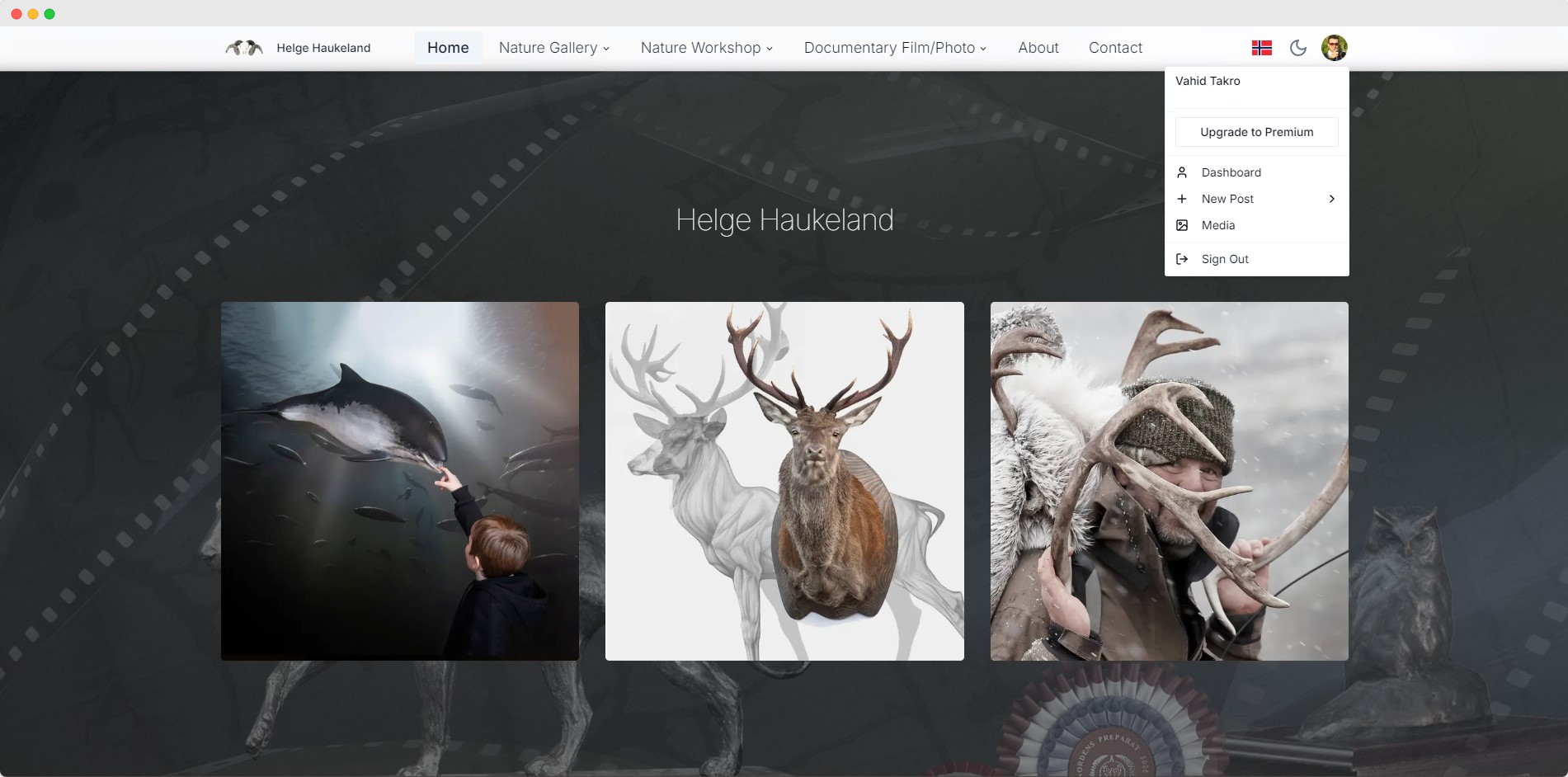
Client Background and Vision
Helge Haukeland stands at the intersection of art and nature, combining his expertise as a taxidermist with his passion for documentary filmmaking and photography. His unique work required a platform that could not only showcase his diverse portfolio but also serve as an educational resource and e-commerce platform. The website needed to present his work in taxidermy, nature workshops, documentary films, and photography while maintaining the highest standards of visual presentation and user experience.
The vision was to create more than just a portfolio site - it needed to be a comprehensive platform that could grow with his business, support various content types, and provide multiple revenue streams through subscriptions, rentals, and e-commerce. The platform needed to cater to both casual visitors interested in his work and serious clients seeking his professional services.
Technical Architecture
Core Technologies
- Frontend: Next.js 14 with App Router, TypeScript, and Tailwind CSS
- Backend: Node.js with Next.js API Routes
- Database: MySQL with Prisma ORM
- Authentication: NextAuth.js with role-based access control
- Media Management: Custom integration with Cloudinary
- Payment Processing: Stripe and Vipps integration
- State Management: React Context and SWR for data fetching
- UI Components: Custom component library built with Radix UI primitives
The technology stack was carefully chosen to provide a robust foundation for the platform's requirements. Next.js 14 with the App Router provides excellent performance through server-side rendering and static generation, while TypeScript ensures type safety across the entire codebase. The combination of Tailwind CSS and custom Radix UI components allows for rapid development of accessible, responsive interfaces while maintaining consistent design language.
Media Management System
Implemented a sophisticated media management system with the following features:
- Custom-built MediaLibrary component with support for multiple file types (images, videos, audio, documents)
- Advanced file organization with folder structure and search capabilities
- Bulk operations: upload, rename, delete, and move
- Image usage tracking system to prevent deletion of in-use assets
- Automatic image optimization and format conversion
- Custom image Cloudinary transformations for different use cases (gallery, single uploads, sliders)
- Integration with Cloudinary's API for CDN delivery and transformations
The media management system is one of the platform's most complex and innovative features. It handles various file types while providing a seamless user experience. The system includes a sophisticated tracking mechanism that prevents the accidental deletion of media files currently in use across the site. The integration with Cloudinary provides automatic image optimization and format conversion, ensuring optimal delivery for different devices and bandwidth conditions.
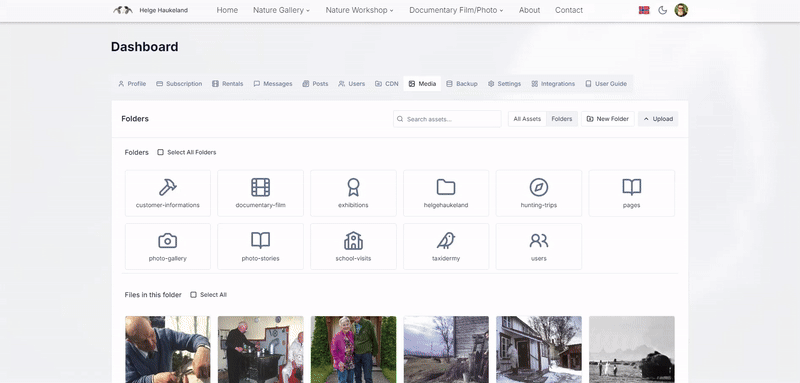
Dashboard Implementation
Created a comprehensive dashboard with modular architecture:
- Role-based access control with admin and user views
- Real-time data updates using SWR for optimistic UI
- Tab-based navigation system with URL persistence
- Custom components for:
- Post management with filtering and sorting
- Media library with drag-and-drop upload
- User management interface
- Site settings configuration
- Backup and restore functionality
- CDN management
- Analytics and reporting
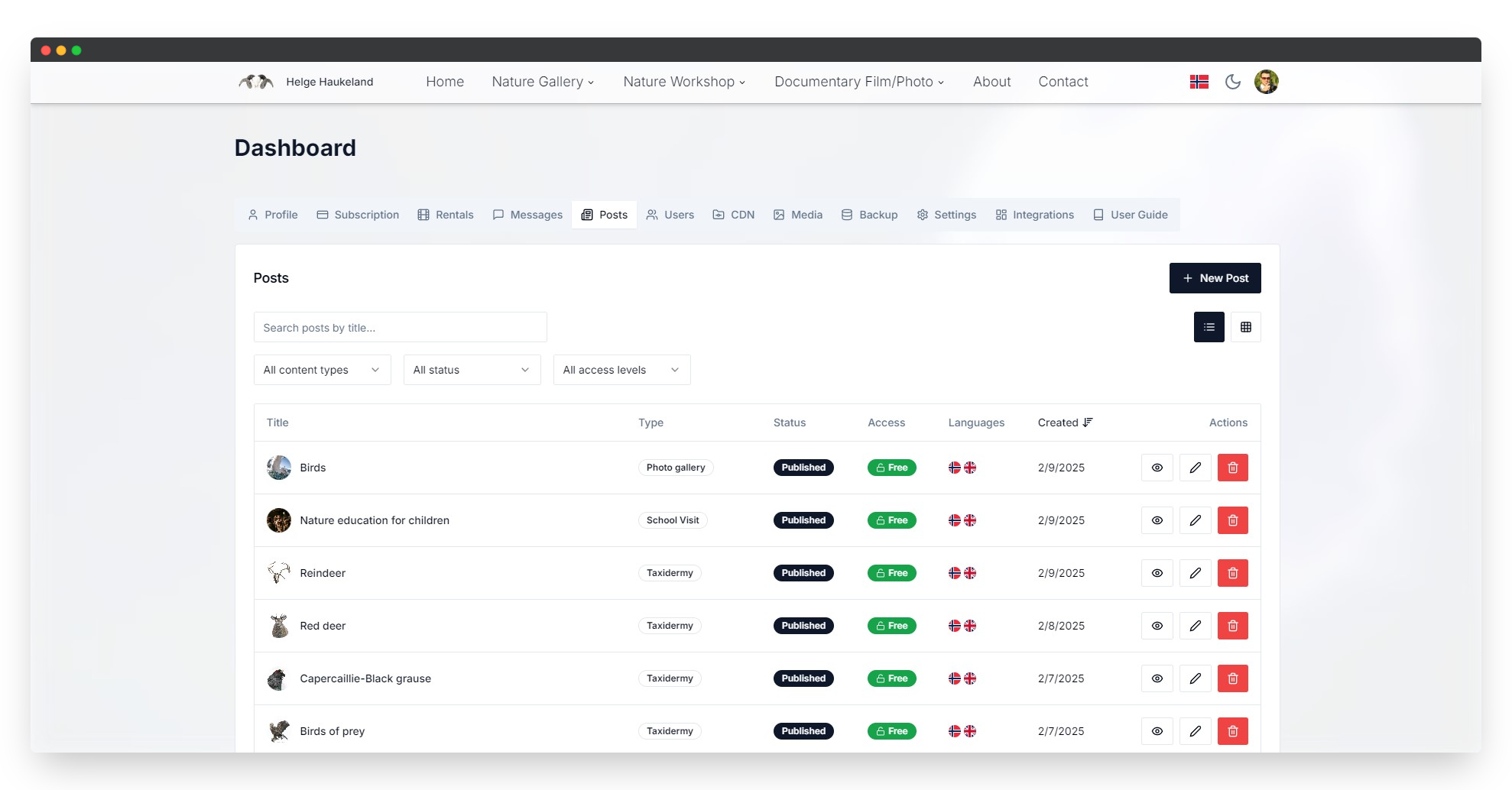
The dashboard serves as the central control panel for the entire platform. Its modular architecture allows for easy extension and maintenance. The use of SWR (stale-while-revalidate) provides real-time updates with optimistic UI, creating a responsive and fluid user experience. The tab-based navigation system maintains state through URL parameters, allowing for easy sharing and bookmarking of specific dashboard views.
Content Management System
Built a powerful CMS with:
- Rich text editor with custom plugins for media insertion
- Multilingual content management with language-specific fields
- Version control for content changes
- Scheduled publishing system
- Custom workflows for content approval
- SEO optimization tools
- Automatic sitemap generation
The custom CMS is built to handle the unique requirements of Helge's content. The rich text editor includes specialized plugins for handling media insertion, with support for image galleries, video embeds, and audio players. The multilingual content management system allows for seamless content creation in multiple languages, with built-in tools for translation management and synchronization.
When administrators log into the dashboard, they're presented with a comprehensive grid-based view of all content, where each post is displayed with quick-action controls for immediate management. The interface enables real-time status updates through SWR (stale-while-revalidate) implementation, allowing administrators to toggle post visibility, edit content, and manage premium access flags directly from the grid view. The system's post management capabilities extend beyond basic CRUD operations, incorporating an advanced rich text editor with seamless image integration and markdown support. For multilingual content, the interface provides side-by-side editing of Norwegian and English versions, supported by AI-powered translation assistance that maintains content consistency across languages. Media management is streamlined through an integrated library system with folder organization and bulk upload capabilities, while custom watermarking options protect premium content. The platform includes sophisticated version control, maintaining a complete revision history with one-click rollback functionality and detailed audit trails of all content modifications.
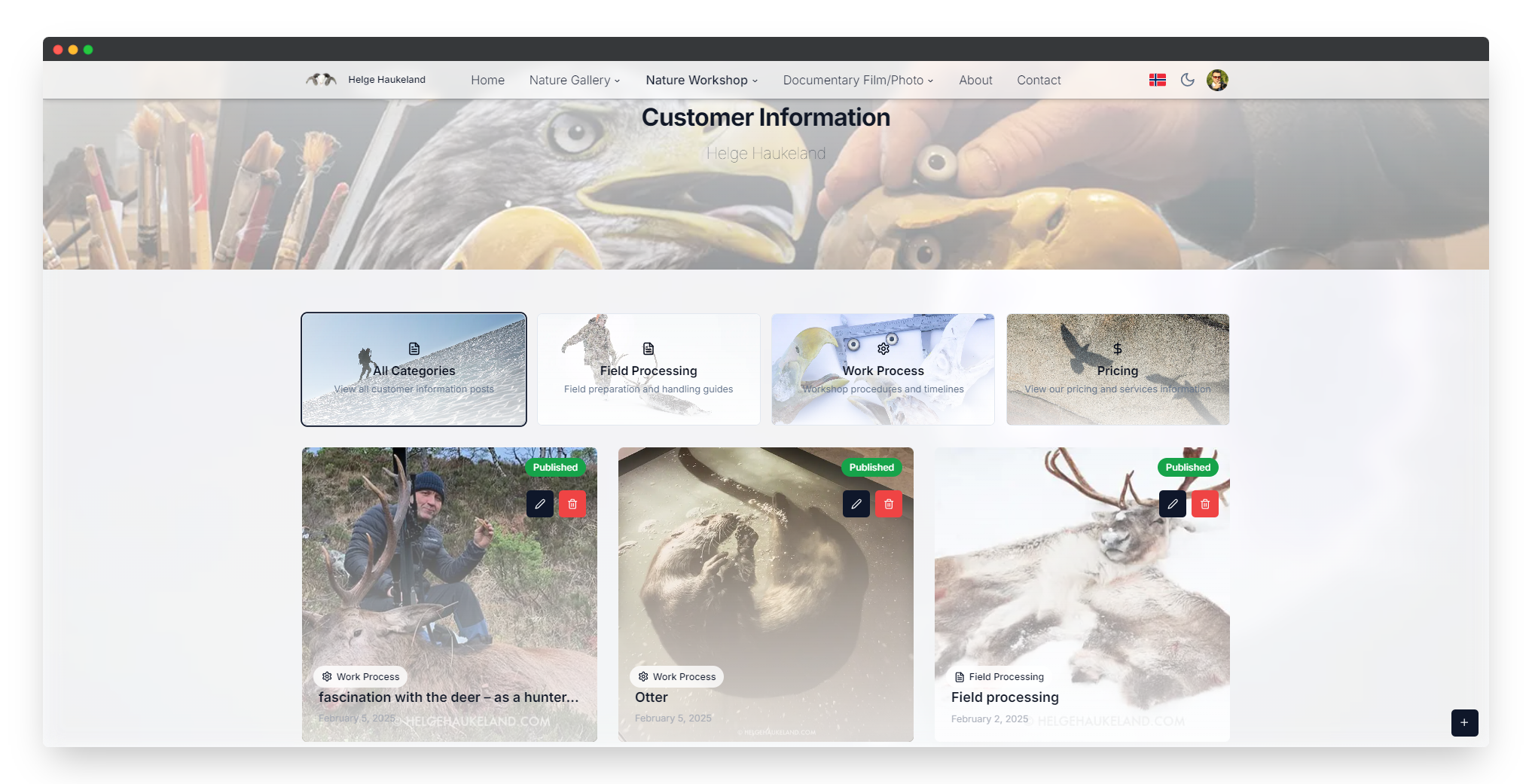
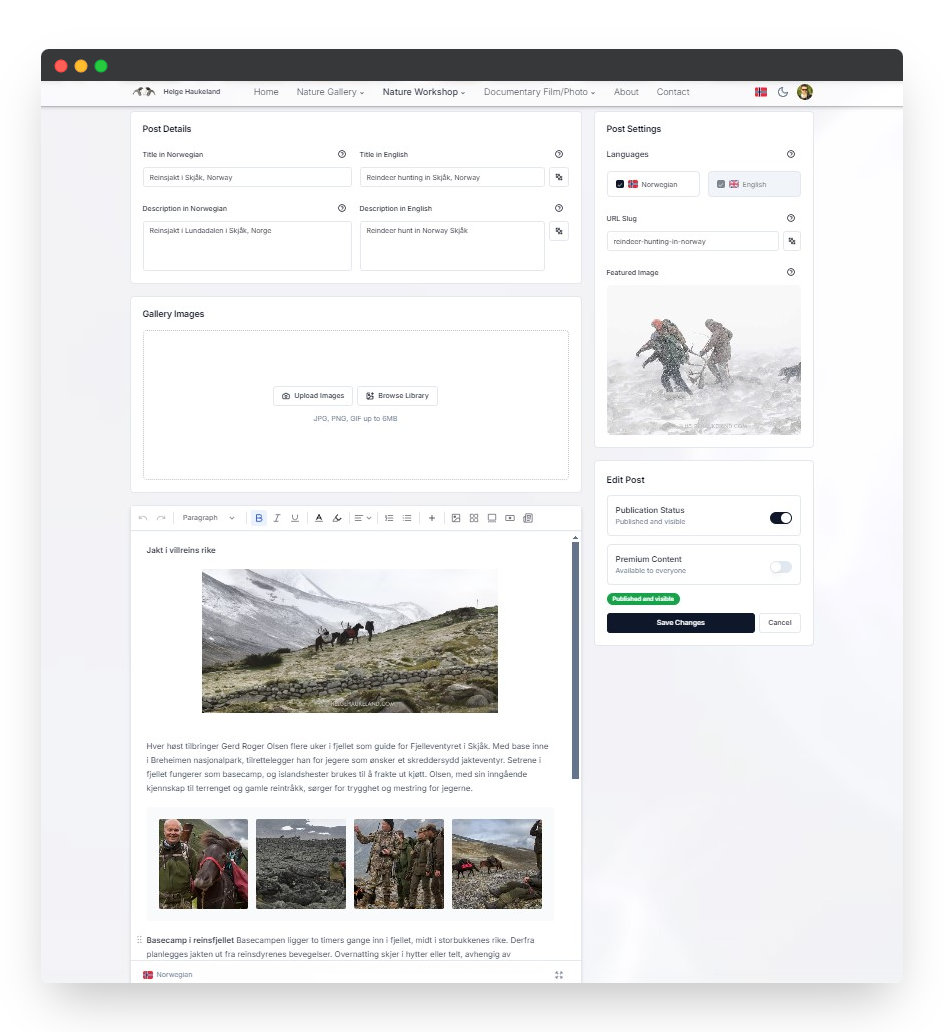
The platform implements a sophisticated role-based content delivery system that adapts based on user authentication status. When an administrator logs in, the system utilizes SWR (stale-while-revalidate) for data fetching, enabling real-time content updates and optimistic UI rendering. This approach allows administrators to see immediate feedback when making content changes, such as toggling post visibility or updating content, without waiting for server confirmation. The admin interface includes floating action buttons on each post page, providing quick access to edit and manage content directly from the frontend. For regular users and non-authenticated visitors, the platform switches to a static generation approach, where content is pre-rendered at build time and revalidated at specified intervals. This dual-approach strategy optimizes both admin functionality and SEO performance. Speaking of SEO, the platform implements comprehensive search engine optimization through dynamic metadata generation for each page. The metadata system automatically generates appropriate title tags, meta descriptions, and Open Graph data based on the content's language and type. The multilingual implementation uses a dual-domain strategy (helgehaukeland.com for English, helgehaukeland.no for Norwegian) with proper language tags and alternate links, ensuring search engines correctly index content for different language markets. The system also generates dynamic sitemaps that update as content changes, implements canonical URLs to prevent duplicate content issues, and uses structured data markup to enhance search result appearance. For media content, the platform implements lazy loading with proper image attributes (alt tags, dimensions, and responsive sources), ensuring both performance and SEO benefits. This comprehensive approach to SEO has resulted in improved search engine rankings and better content discoverability across both language markets.
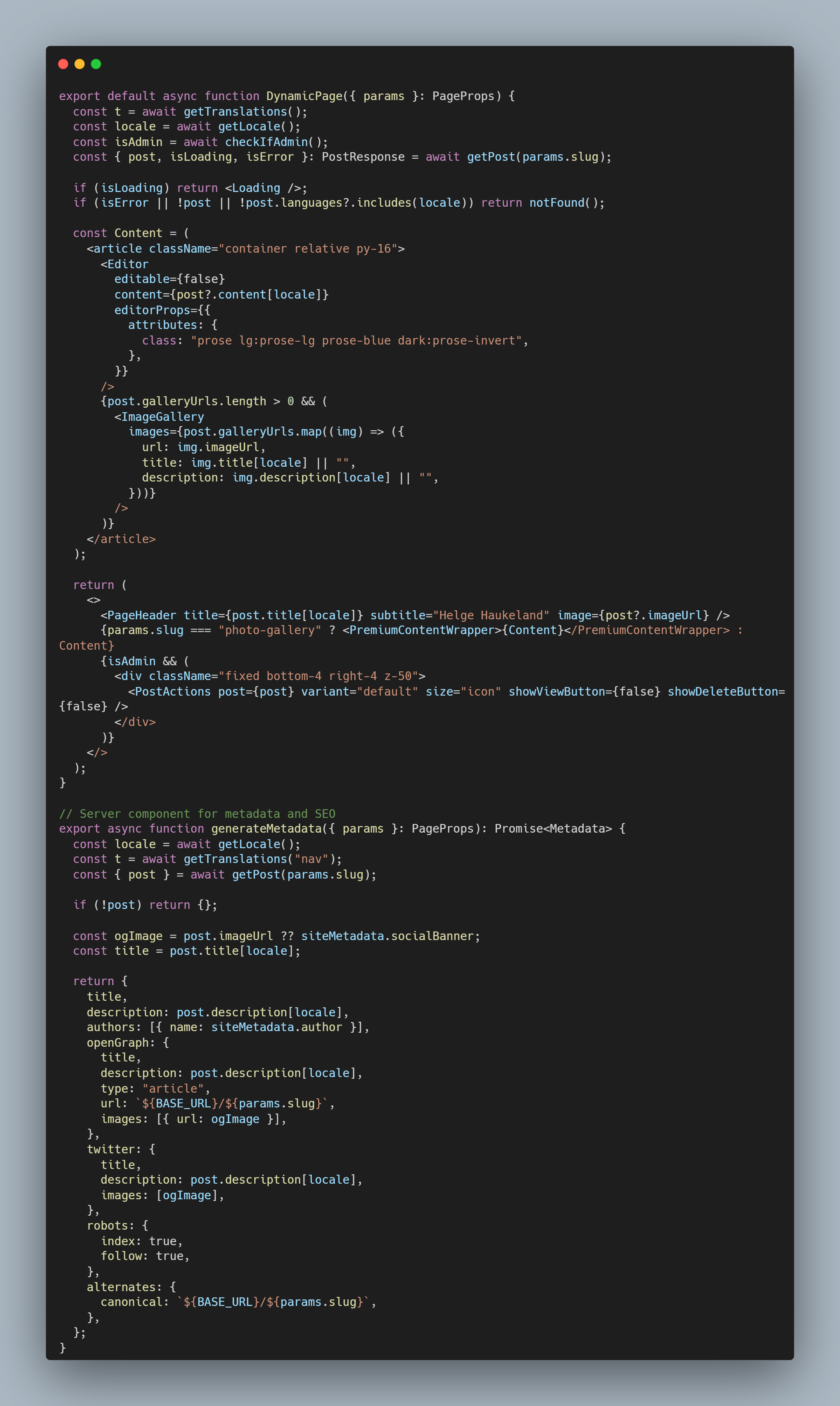
Authentication and Security
Implemented robust security measures:
- NextAuth.js integration with multiple providers
- JWT-based session management
- Role-based access control (ADMIN, USER roles)
- API route protection with middleware
- CSRF protection
- Rate limiting on sensitive endpoints
- Secure password handling with bcrypt
Security was a primary concern throughout development. The authentication system uses NextAuth.js with a custom JWT implementation, providing secure user sessions while maintaining flexibility. Role-based access control ensures that users can only access appropriate content and functionality. The system includes comprehensive protection against common web vulnerabilities, with rate limiting on sensitive endpoints to prevent abuse.
Database Architecture
Designed a scalable database schema using Prisma:
- Relational data model for content management
- Efficient queries with proper indexing
- Transaction support for data integrity
- Automated database migrations
- Backup and restore functionality
- Data validation at the schema level
The database architecture is designed to handle complex relationships between different types of content while maintaining performance. The schema includes sophisticated indexing strategies for optimal query performance. The use of Prisma provides type-safe database access with automated migrations, ensuring data integrity throughout the application's lifecycle.
Performance Optimizations
Implemented various performance enhancements:
- Image optimization pipeline with Cloudinary
- Incremental Static Regeneration for dynamic pages
- Efficient data fetching with SWR
- Code splitting and lazy loading
- Caching strategies for API responses
- Database query optimization
- CDN integration for media delivery
Performance optimization was achieved through a multi-layered approach. The image optimization pipeline ensures fast loading of visual content while maintaining quality. Incremental Static Regeneration provides the benefits of static generation for dynamic content. The combination of efficient data fetching, code splitting, and caching strategies results in a fast, responsive user experience.
Multilingual Support
Developed a comprehensive internationalization system:
- Dynamic language switching without page reload
- SEO-friendly URL structure for each language
- Fallback language support
- Translation management interface
- Automatic language detection
- RTL support for future expansion
The multilingual system uses a sophisticated approach to content management. Each piece of content can exist in multiple languages, with automatic fallbacks when translations are not available. The system includes tools for managing translations and maintaining consistency across language versions. The URL structure is designed to be SEO-friendly while providing clear language indicators.
Development Practices
Followed industry best practices:
- Type-safe development with TypeScript
- Component-based architecture
- Responsive design principles
- Automated testing with Jest and React Testing Library
- CI/CD pipeline with GitHub Actions
- Code quality maintenance with ESLint and Prettier
- Comprehensive documentation
- Git workflow with feature branches
The development process followed strict quality standards throughout. The use of TypeScript ensures type safety across the codebase, while the component-based architecture promotes reusability and maintainability. Automated testing covers critical functionality, with continuous integration ensuring code quality through automated checks and deployments.
Technical Challenges and Solutions
- Media Management: Developed a custom media library component to handle large files and provide a seamless user experience, implementing lazy loading and virtual scrolling for performance.
The media library component was built to handle files up to 4GB in size, with specialized handling for different file types. The implementation includes a custom virtual scrolling solution that efficiently renders only the visible items in large galleries, significantly reducing memory usage and improving performance. The system also implements resumable uploads for large files, allowing users to pause and resume uploads without data loss.
Additional media management features:
- Custom watermarking system with dynamic configuration
- Secure media delivery through Cloudinary and custom CDN
- Advanced file organization with folder structures
- DRM-protected video streaming
- Progressive image loading

- Real-time Updates: Implemented optimistic updates using SWR to provide instant feedback while ensuring data consistency.
The real-time update system uses a sophisticated combination of SWR for data fetching and WebSocket connections for live updates. The optimistic UI updates immediately reflect user actions while background synchronization ensures data consistency. The system includes automatic conflict resolution and retry mechanisms for failed operations.
- Performance: Optimized image delivery through Cloudinary's transformation API and implemented efficient caching strategies.
The performance optimization strategy includes:
- Dynamic image transformations based on device capabilities
- Automatic WebP and AVIF format conversion
- Progressive image loading with blur placeholders
- Intelligent preloading of critical resources
- Implementation of service workers
- Advanced caching strategies
- Code splitting and dynamic imports
- Security: Created a robust authentication system with role-based access control and API route protection.
The security implementation includes:
- Multi-factor authentication support
- IP-based rate limiting
- Advanced JWT token rotation
- Secure file upload validation
- Content security policies
- Automated security headers
- Regular security audits
- Scalability: Designed the database schema and API routes to handle increasing content and user load efficiently.
The scalability solution includes:
- Horizontal scaling capability
- Database query optimization
- Efficient caching layers
- Automated backup procedures
- Load balancing configuration
- Database sharding preparation
- Multilingual Implementation: Created a sophisticated multilingual system to serve both Norwegian and English-speaking audiences effectively.
The multilingual solution includes:
- Dual-domain strategy (helgehaukeland.com for English, helgehaukeland.no for Norwegian) using next-intl
- Custom AI-powered translation system using Google Cloud Translation API with Cohere AI fallback
- Sophisticated content model storing multiple languages in JSON structure
- Language-specific SEO optimization with dynamic metadata generation
- Automatic content synchronization across languages
- Real-time translation assistance for content creators
Future Scalability
The platform is designed for future expansion with:
- Modular architecture for easy feature additions
- Scalable database design
- Extensible API structure
- Support for additional payment providers
- Capability to handle increased traffic and content volume
Backup System
The backup system implements a sophisticated data preservation strategy with both automated and manual backup capabilities. The automated system runs daily backups at scheduled intervals, retaining copies for 30 days to ensure data safety. For manual backups, administrators can choose from multiple export formats including JSON, CSV, SQL, or a complete backup that includes all media assets. The system integrates with a secure storage API that handles large file operations efficiently, implementing proper authentication through JWT tokens. When including media files, the backup process creates a compressed ZIP archive containing both the database content and associated media files. The interface provides real-time progress feedback during backup operations and includes a comprehensive backup history table that displays filename, format, size, and creation date for each backup. The system also implements intelligent error handling and retry mechanisms for failed backup attempts. A particularly noteworthy feature is the backup size formatting utility that automatically converts bytes to appropriate units (B, KB, MB, GB) for better readability. The restore functionality is protected by role-based access control, ensuring that only authorized administrators can perform critical backup operations. Would you like me to create a carbon.now.sh screenshot of the backup system's core implementation? I can highlight the most interesting parts of the code, such as the backup format selection, media inclusion logic, and the secure download implementation.
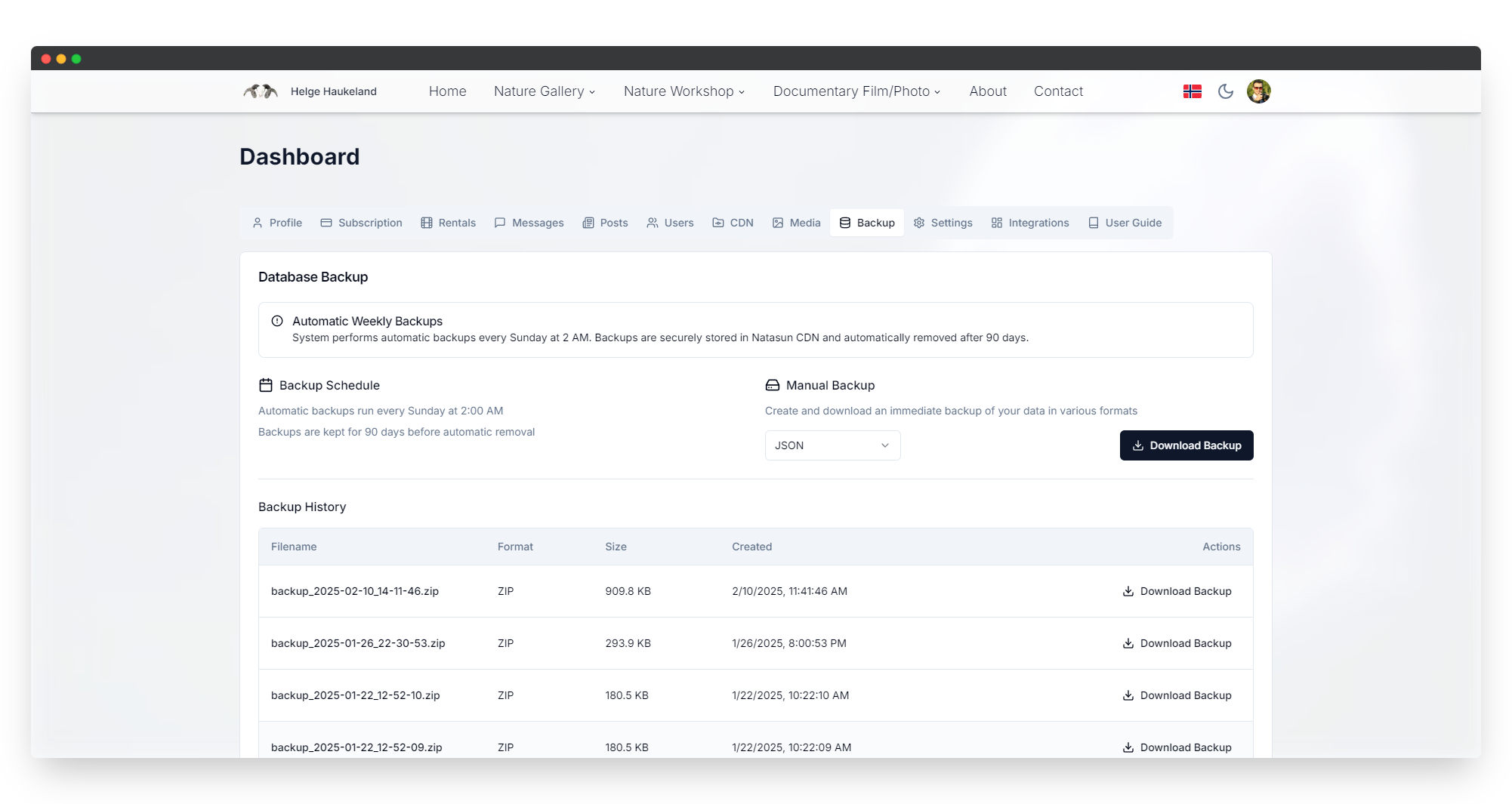
Subscription and Rental System
The subscription and rental system represents a sophisticated approach to content monetization. Users can purchase time-based access to premium content, with the system automatically managing access control and content delivery. The integration with Stripe and Vipps provides flexible payment options, while the rental system includes features like automatic expiration and renewal handling.
Form Generation and Content Types
One of the most technically challenging aspects was creating a dynamic form generation system that could handle various content types while maintaining type safety and validation. The system adapts to different content requirements while preserving data integrity, allowing for flexible content creation while ensuring data consistency.
Custom Editor Extensions
The project features sophisticated custom editor extensions that enhance content creation capabilities. The gallery extension provides a comprehensive media management system with drag-and-drop organization, advanced image processing through Cloudinary integration, and multilingual description support. It handles secure image deletion and implements watermarking based on user settings.
The related posts extension enables dynamic content relationships with smart post selection and real-time preview capabilities. It maintains language consistency across content and implements custom preview layouts that adapt to different display formats. This extension particularly shines in creating contextual relationships between different types of content, from documentary films to photo galleries.
The slider extension offers advanced presentation capabilities with flexible content positioning and responsive image handling. It features an interactive preview system and sophisticated media integration that optimizes images for performance while maintaining quality. The extension supports various content layouts with left/right positioning options and maintains consistent aspect ratios across different screen sizes.
All extensions share a robust foundation of state management, error handling, and security features. They work seamlessly together while maintaining independence, allowing content creators to build rich, interactive content without compromising on performance or user experience. The implementation demonstrates careful consideration of real-world usage scenarios, with comprehensive error handling and user feedback mechanisms.
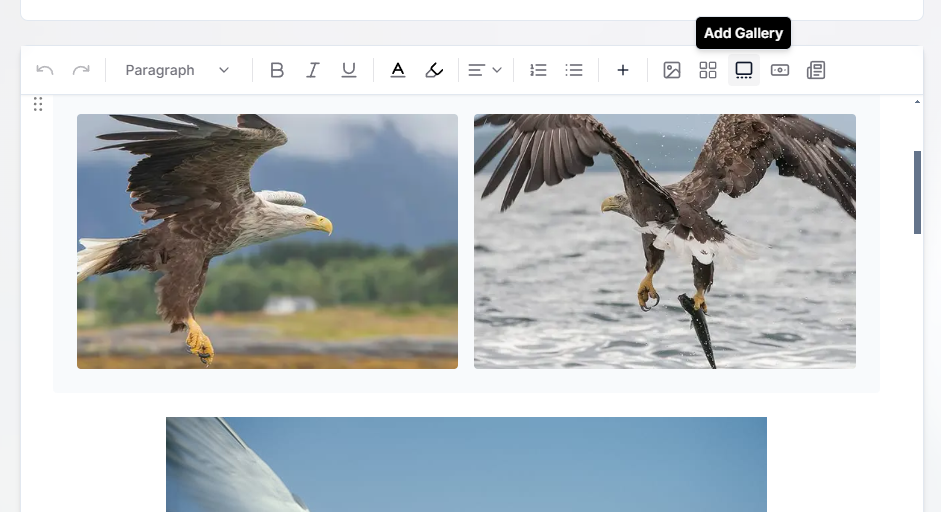
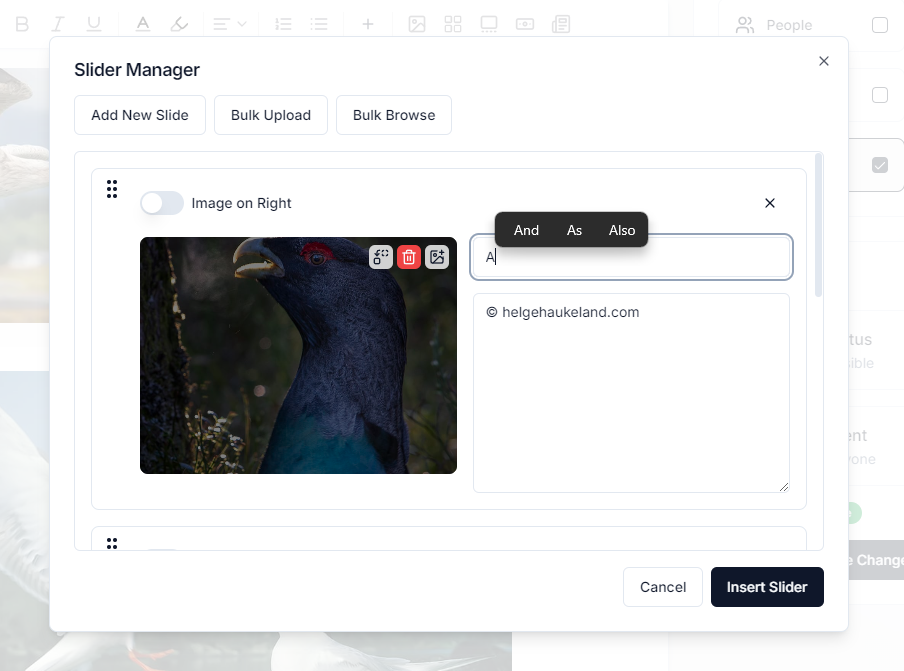
Impact and Future Scalability
The platform has successfully transformed Helge Haukeland's digital presence, providing a sophisticated system for content management and monetization. The architecture is designed for scalability, with clear separation of concerns and modular components that can be extended as needs evolve. The system's success is measured not just in technical terms but in its ability to serve as an effective platform for showcasing and monetizing Helge's unique work.
This project demonstrates my ability to architect and implement complex full-stack solutions that combine technical sophistication with practical business value. It showcases expertise in modern web development practices while maintaining a focus on user experience and system maintainability.